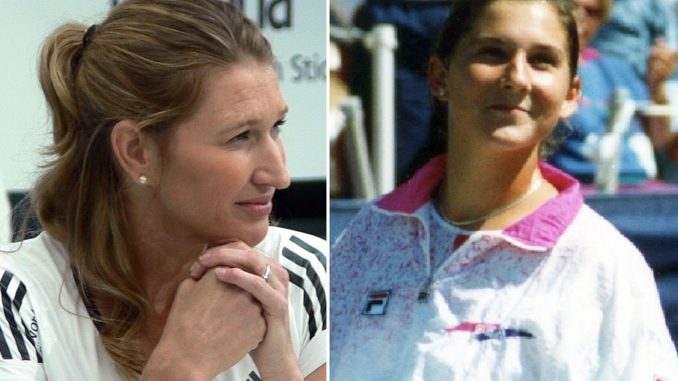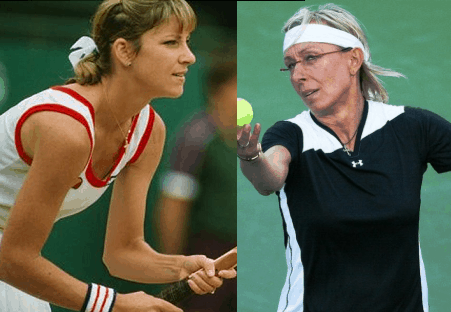
There have been many a great tennis rivalries but some have captured imagination more than others for the edge they brought to the sport. Here’s a list of two of our six interesting but edgy rivalries in tennis.
Continuing from where we left off in the Part II of Great and Edgy Tennis Rivalries here, here’re the next set.
Chris Evert v Martina Navratilova
Closing this list of Six Great Rivalries is a friendship story, more than anything else. Borg and McEnroe, Nadal and Federer, those players actually need each other.
When he talks about Björn’s retirement, John is close to tears. There is loyalty to be found in epic rivalries, and Chris Evert and Martina Navratilova exemplify this beautifully.
When these two arrived on the tennis circuit in the early seventies, the WTA Tour was being put together by a movement spearheaded by Billie Jean King, who then relied strongly on both Evert and Navratilova to make it work. A tournament was considered a success if at least one of them made it into the draw.
[the_ad id=”14063″]
Both were fierce competitors, although, typically, they had very different games. Navratilova was excellent at the net, attacking every ball like it just had to win the point; Evert, consistent from the baseline, patient, just as determined to win the match, but a little quieter.
The two played each other a grand total of eighty times. That’s twice the number of matches played between Federer and Nadal, and four times that of Sharapova versus Serena.
They both pocketed 18 major titles, and have each other to thank for it. None of them shy away from the symbiosis that elevated their games over the 15-year period of their rivalry, roughly from 1973 to 1988 – according to sports columnist Bud Collins, “The Rivalry of the Century.”
Also Read:
- Grigor Dimitrov’s Career So Far: Successful or Disappointing?
- Remembering Michael Stitch’s Shocking Wimbledon Triumph
Navratilova commented:
“Chris made me better, then I made her better.”
The American went down a similar path “She made me better, and I don’t know if anybody else would have done that.”
In terms of results, Martina was better on grass, a surface well-fitted for her fast-pace game, while Evert leads the head to head on clay.
However they both learned from the other and molded their tactics according to how the other played, and eventually the field was levelled – between their last Slam (the 1986 French Open) and their last meeting (at Wimbledon 1988), they played a total of 10 matches. Five were won by Chris, five by Martina.
This rivalry has already gone down in history as one of the most productive, fertile competitive relationships tennis has ever seen. They both wanted number one – and got it – but they were also incredibly aware of how much they meant to each other.
These days, you can spot ‘Chrissie’ complimenting Martina on her career, looking at her with pride and awe alike. You might find that Martina does the exact same thing – a great example of how rivalries can lead to the very best in sports.

Steffi Graf v Monica Seles
In an episode of the TV show 60 minutes dedicated to tennis and aired in 1995, the host tells his audience about the burning rivalry between Andre Agassi and Pete Sampras, and adds, “But in women’s tennis right now, it’s just Steffi, Steffi, and Steffi.”
Steffi Graf, a German tennis player who came about in the late 80s, was indeed hot stuff at the time. She took over the legendary Martina Navratilova to become the top player on the WTA circuit in 1987, going on an incredible run of 186 consecutive weeks at number one. It seemed like nothing and no one would ever stand in her way.
But history has a way of contradicting even the safest predictions. An unusual player from Yugoslavia was on her way to upset Graf, and eventually surpass her in ranking in 1991: her name was Monica Seles.
Graf was a natural athlete, dubbed in the 60 minutes show as the “Formidable Fraulein of the lady’s circuit”.
[the_ad id=”14063″]
From the moment she turned pro, at the prime age of 13 years old, to her first Wimbledon win at 15 and becoming n°1 at eighteen, up until the beginning of her rivalry with Seles, she was widely viewed as the best of the best, unbeatable on all surfaces.
Seles was close behind, and running fast – from 1988 to 1989, she rose from n°86 in the world to n°6, to reach n°2 in 1990, and n°1 in both 1991 and 1992.
She played with both hands on both sides, she grunted a lot on the court (which Navratilova famously compared to the sounds made by a “stuck pig” after a loss against Seles), and she stood further inside the baseline than anyone, inspiring a lot of future players to be more aggressive on the court.
Serena Williams said:
“Growing up, I wanted to be just like her; I wanted to hit like her, to play like her.”
The two players had very styles, but talent in equal measure. They were naturally drawn into a tennis rivalry that looked quite level for years.
The first instance of this rivalry occurred at the German Open in 1990, where Seles broke Graf’s 66 match winning streak in the final. Monica clinched the French Open title that same year, winning a Slam at 17, and becoming the youngest female player yet to reach n°1 in 1991 (a record later beat by Hingis, at 16).
Graf and Seles met six times in Grand Slam finals, and tie at three wins each: 2 US Open titles and one Wimbledon for Graf, 2 French Opens and one Australian Open for Seles. The perfect tie doesn’t translate to the rest of their head-to-head however, with a final count of 10 to 5 lead for Steffi. The world was ready for more matches when history took a horrific turn.
At the Citizen’s cup in Hamburg, Germany, during a quarter-final match, Seles fell victim to a fateful act. Gunter Parche, a mentally unstable man, ran up to her bench during a break between two games and stabbed Monica between the shoulder blades.
A fervent Steffi Graf fan, he stated his motive: to let Steffi be number one again.The tragic incident stopped Monica dead in her tracks.
Chris Evert commented:
“She was on top of the world, then she was in the gutter.”
She lost millions in endorsement contracts, her top ranking, and most of all, her self-confidence. Steffi was understandably shaken by the story as well, and their rivalry took a more muted, careful, almost sad turn.
Seles came back to the game in 1995, winning the Canadian Open right away, but lost to Graf in the US Open final. After the stabbing, she only won against Graf once more, against four wins for Steffi.
The two players had incredible careers, but this specific rivalry has left a sour taste in the mouths of many tennis fans across the world. They would have wanted more from what seemed like one of the most interesting and dynamic competitions in tennis; they would have wanted to see both players compete for number one for longer.
In the end, Steffi took the lead. Her talent and determination were enough to justify her achievements, but as far as the Graf v Seles story goes, there will always be a question mark – what if..?
Be the first to comment